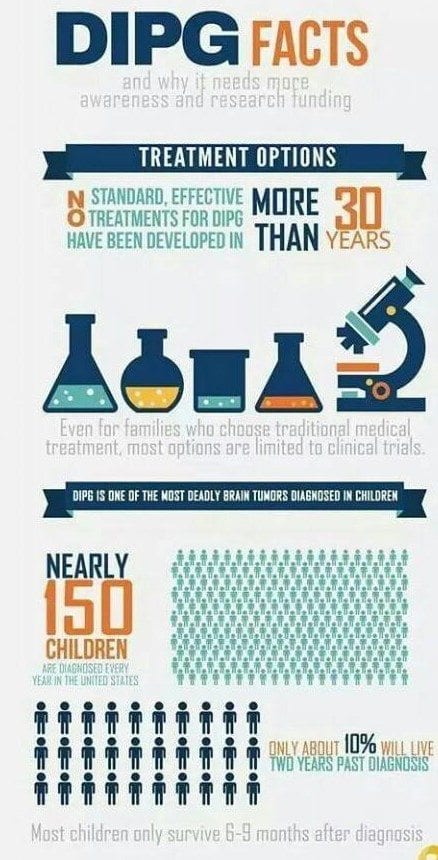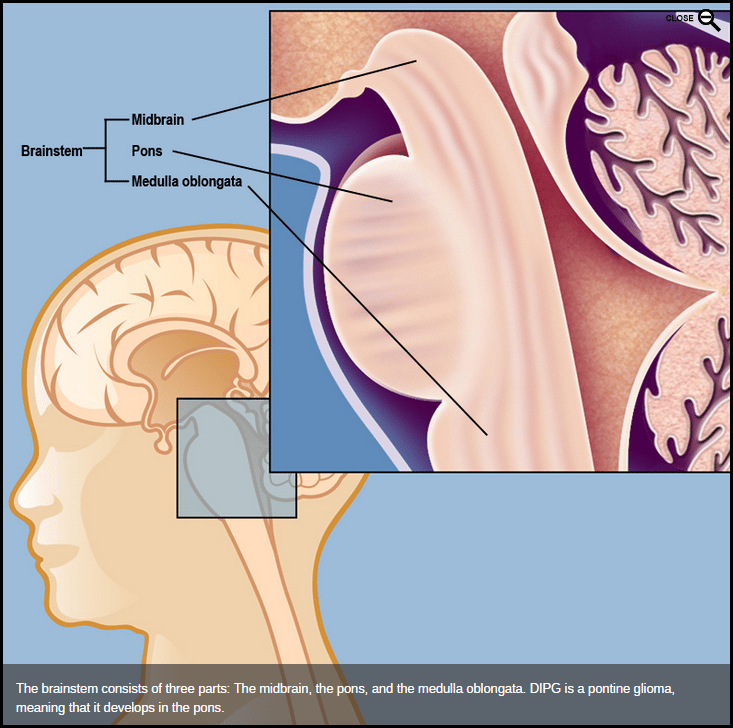For additional information, visit DIPGregistry.org
DIPG (Diffuse Intrinsic Pontine Glioma) is a disease that strikes at the heart of childhood and is in desperate need of a cure. There may be no better place to start the search for a home run cure for all cancer.
DIPG is an extremely invasive tumor that occurs in the brainstem, which is at the base of the skull and controls such vital functions as breathing and heart rate. DIPG affects the pons portion of the brainstem, rendering nervous system function impossible. Symptoms include double vision, inability to close the eyelids completely, facial paralysis, and difficulty chewing, swallowing and eventually breathing. Unfortunately, these symptoms usually worsen rapidly because the tumor is fast growing and aggressive. Doctors have referred to DIPG as the WORST type of cancer in the WORST possible place.
DIPG, for all its difficulties, presents an opportunity for ALL forms of cancer. It is one of the most resistant of all cancers to chemotherapy treatments; it affects primarily children (whose treatment has historically led to innovations in many other forms of cancer), and with a “dismal” prognosis, alternatives are few.
Put together, these obstacles offer researchers a chance to revolutionize cancer research and prevention. It is even suggested that a cure to DIPG may result in a cure for almost every other type of cancer. We strive to generate the resources necessary for doctors to study DIPG and implement the findings in the hope of curing DIPG, and hopefully all cancers.
Diffuse Intrinsic Pontine Glioma, commonly referred to as pontine glioma, infiltrative brainstem glioma, or DIPG, is a rare tumor of the brainstem that occurs almost exclusively in children. A pontine glioma occurs in a most delicate area of the brainstem (the “pons”), which controls many critical functions, including breathing and blood pressure. Its location, as well as the way it infiltrates normal brain tissue, makes it especially difficult to treat. There are about 300-350 new cases of DIPG diagnosed each year in the United States, usually in children under the age of 10. DIPG affects boys and girls equally.
DIPG is a kind of glioma, meaning that it originates from the glial (connective/supporting) cells of the brain. Gliomas of the brainstem, like DIPG, are uncommon in adults, but in children, they are the leading cause of death from brain tumors. (In adults, the most common type of glioma is glioblastoma multiforme, or GBM, the brain tumor that in recent years took the lives of Senator Edward Kennedy and baseball star Gary Carter.) In the United States, there are about 400 new diagnoses a year of brainstem gliomas, and most of these are DIPG.
Pontine gliomas grow quickly, so symptoms can appear suddenly and progress rapidly (see Symptoms of DIPG). Radiation treatments can help alleviate those symptoms, but they are not a cure. The prognosis for DIPG remains poor, but there are promising new research and clinical trials hold the hope of improved outcomes for children diagnosed with DIPG (see Diagnosing and Treating DIPG). It is important to have your child evaluated as soon as possible by an expert in pediatric brain tumors to ensure that the most advanced treatment options are available to you.
What Causes DIPG?
Scientists do not yet know what causes DIPG, and the cancer is so rare that it hasn’t received nearly enough research funding to find a cause, a cure, or even better treatment options. Survival rates have not improved much over the last few decades due to this lack of new research. Because of this, DIPG was chosen as one of the rare and inoperable pediatric brain tumors now being studied in the Weill Cornell Pediatric Brain and Spine Center’s
Information found on Weill Cornell Brain and Spine Center
Symptoms of DIPG
Because the brainstem controls blood pressure, breathing, and a number of other critical life functions, DIPG can cause significant neurological problems. Pontine gliomas often affect the cranial nerves, so many of DIPG’s early symptoms appear in the facial muscles, often affecting the eye and eyelid movements.
The tumor grows so fast that symptoms often appear suddenly and get worse quickly. The most common symptoms of DIPG are:
- Problems with eye movement. The most common one is difficulty looking to the side. Double vision is common because of the loss of alignment of the eyes. Other problems of eye movement include drooping eyelids and inability to close the eyes completely. Often, the problems are seen in both eyes.
- Facial weakness, drooping on one side of the face
- Sudden appearance of hearing problems, including deafness.
- Trouble chewing or swallowing, gagging while eating
- Limb weakness, difficulty standing or walking, abnormal gaits, unbalanced limb movements
- Headache
- Nausea and vomiting from brain edema (swelling) or hydrocephalus. Hydrocephalus is a condition in which the flow of cerebrospinal fluid around the brain is blocked, causing an increase in pressure inside the skull. About 10 percent of DIPG patients have hydrocephalus at the time of diagnosis.
Most children with headaches do not have brain tumors, of course, but anyone with neurological symptoms like those listed above should be evaluated by a physician. Suspected or confirmed brain tumors should be referred to a neurosurgeon for evaluation.
Information found on Weill Cornell Brain and Spine Center
Diffuse infiltrative pontine glioma, or DIPG, is a very rare, incurable brain stem tumor. A pontine glioma occurs in a most delicate area of the brain stem (the “pons”), which controls many critical functions, including breathing. Its location, as well as its infiltrating pattern, means a pontine tumor cannot be safely removed through surgery. Chemotherapy is frequently ineffective, since anti-cancer drugs cannot cross the blood-brain barrier and reach the tumor. Radiation is the most common treatment, but unfortunately, the benefit is only temporary and does not provide a cure.
There are about 300 new cases of DIPG diagnosed each year, usually in children under the age of 10. Each of those new cases represents a devastated family struggling to find a cure for their child, but the odds are against them. Survival time for a child diagnosed with DIPG is measured in months, and there has been no significant increase in survival rates over the past three decades.
Information found on Weill Cornell Brain and Spine Center
Diagnosing and Treating DIPG
Unlike some other tumors, a pontine glioma is not usually biopsied. DIPG is usually diagnosed based on the patient’s symptoms and magnetic resonance imaging (MRI) studies. MRI scans produce detailed images of the brain and allow doctors to detect the presence of a tumor. Sometimes the patient is also given a contrast agent (a special dye) before the scan, so the tumor stands out against normal brain tissue and is easier to view. The location in the pons, the way it infiltrates nearby tissue, and the lack of clear borders of the tumor all signify that a tumor is indeed DIPG.
If the child’s symptoms and the MRI images are not typical, a stereotactic biopsy may be required to make a diagnosis. In this case, a small hole is drilled in the skull and a needle is inserted through the hole to take a small piece of tissue for testing. A pathologist will examine the sample and make a diagnosis.
Treatment for DIPG
Although surgery is the treatment of choice for many other types of brain tumors, it’s usually not possible for children with DIPG because the tumor infiltrates extensively into normal brain tissue, making surgical removal impossible. Chemotherapy has not been proven effective, since anti-cancer drugs cannot cross the blood-brain barrier and reach the tumor.
Radiation therapy is the primary treatment for DIPG. Radiation therapy uses X-rays directed at the tumor to help shrink it and reduce pressure on the brain. That can alleviate symptoms quickly and hold the cancer at bay for several months. Unfortunately, DIPG tends to recur after a few months, and repeated radiation treatments are not well tolerated.
Information found on Weill Cornell Brain and Spine Center




